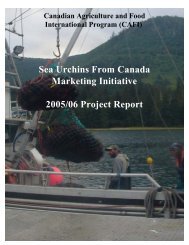Japan Trip 2005 Nemuro - Pacific Urchin Harvesters Association
Japan Trip 2005 Nemuro - Pacific Urchin Harvesters Association
Japan Trip 2005 Nemuro - Pacific Urchin Harvesters Association
You also want an ePaper? Increase the reach of your titles
YUMPU automatically turns print PDFs into web optimized ePapers that Google loves.
Appendix B: IUU <strong>Urchin</strong> Landing in Hanosaki, Hokkaido, <strong>Japan</strong> Page 3<br />
Still, it seems there is a bit of a disconnect here somewhere because the Russian boats with the<br />
illegal product are not apparently impeded whatsoever by the <strong>Japan</strong>ese Coast Guard or Port<br />
Authorities. It seems that the RCG is the only authority with the ability to establish the legality of<br />
the product on board the vessels while the JCG is limited to only ensuring that the import<br />
documentation is in order and this may not reference the legal harvest licence documentation<br />
because it could be seen as a encroachment on Russian sovereignty.<br />
At any rate, the combined legal and IUU urchin landings in <strong>Japan</strong> each year from the Kuriles<br />
total approximately 10,000 MT of urchins even though the official quota for the area has only<br />
been recently raised from 1,200 MT to 2,000 MT. This implies that about 8,000 MT are IUU<br />
urchins. The landed prices for this product range from about ¥150 /kg when the market is in poor<br />
shape to about ¥600/kg when it is strong. This compares with CIF prices for live Canadian GSU<br />
ranging between about ¥ 850- 1,020/kg which incorporates a shipment cost of about ¥295/kg<br />
which also applies to the approximate 20% throw-away weight for packaging.<br />
The majority of the IUU fishery is reportedly prosecuted in the Hobomai Group out to Shikotan<br />
Island. The transit times to Hanosaki Port from these are in the neighbourhood of six hours so<br />
while stocks are reported in other areas of the Kuriles, the shipping distances and costs are that<br />
much greater. Still, the shipping cost for the currently fished Russian IUU product is reported to<br />
come in about ¥1/kg, so there would seem to be some room to extend out into other areas. There<br />
are also some reports of large stocks of old Green Sea <strong>Urchin</strong>s, S. droebachiensis, around the<br />
eastern half of Etorufu Island, the Kurile lying furthest from Hokkaido, but these have never been<br />
fished and their condition etc. is reported to be pretty poor which, along with the extra transport<br />
costs involved, means fishing them is not worth the effort at this point.<br />
The prices for the currently available Russian product, especially at the lower end, are very low<br />
and the volumes involved are such that the market is spending much more time in a weak<br />
condition because of an over-supply situation. As a result, many of the smaller processing<br />
companies in Northern <strong>Japan</strong> are (almost) forced to use the IUU product simply to keep their<br />
doors open. Legitimate urchin producers, including importers competing during the winter<br />
months when the Russian IUU fishery is active, and larger and perhaps more diversified<br />
processors are being severely disrupted as legally obtained product simply cannot compete.<br />
The quota for the Kuriles was raised in <strong>2005</strong> although the reasons behind it are somewhat<br />
convoluted. In part it reflects the reality of the IUU harvest but on the other hand it simply<br />
disregards the over-harvesting that is occurring as a result. In one respect the government has<br />
(possibly) increased the proportion of the catch which is subject to taxation but on the other hand<br />
the stock depletion is not being factored in. The official Fisheries Institute resources for the<br />
Sakhalin area, which has jurisdiction over the Kuriles, are not sufficient to allow direct research<br />
to estimate the biomass and/or set area quotas in the Kuriles so they rely instead on a private<br />
contractor to conduct the work. The company involved apparently uses only the official Russian<br />
harvest estimates which do not recognize or acknowledge the IUU harvest as significant. The<br />
contractors reportedly recycle the same data each year and they would seem to be factoring in<br />
some biomass increases in the area that might be expected because of the sustainable utilization<br />
rate obtained from the official harvest numbers.<br />
Explorations UnLimited Inc. November <strong>2005</strong>





